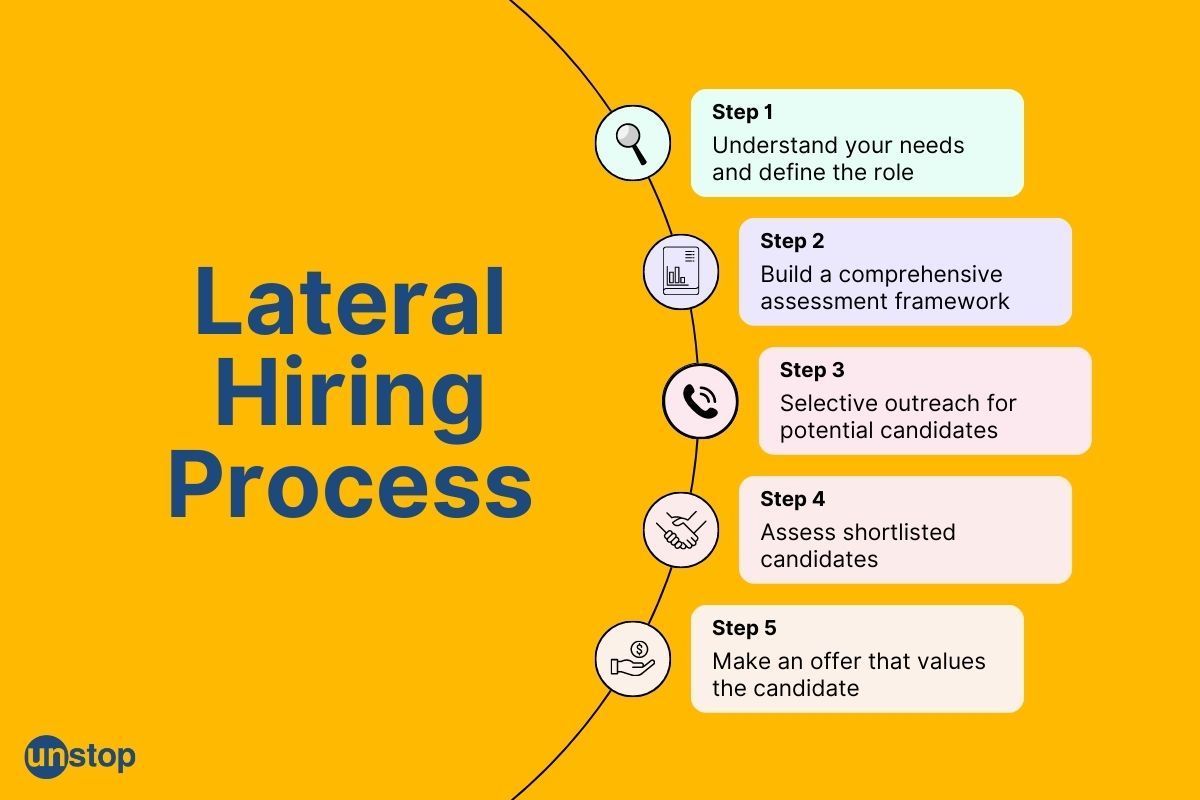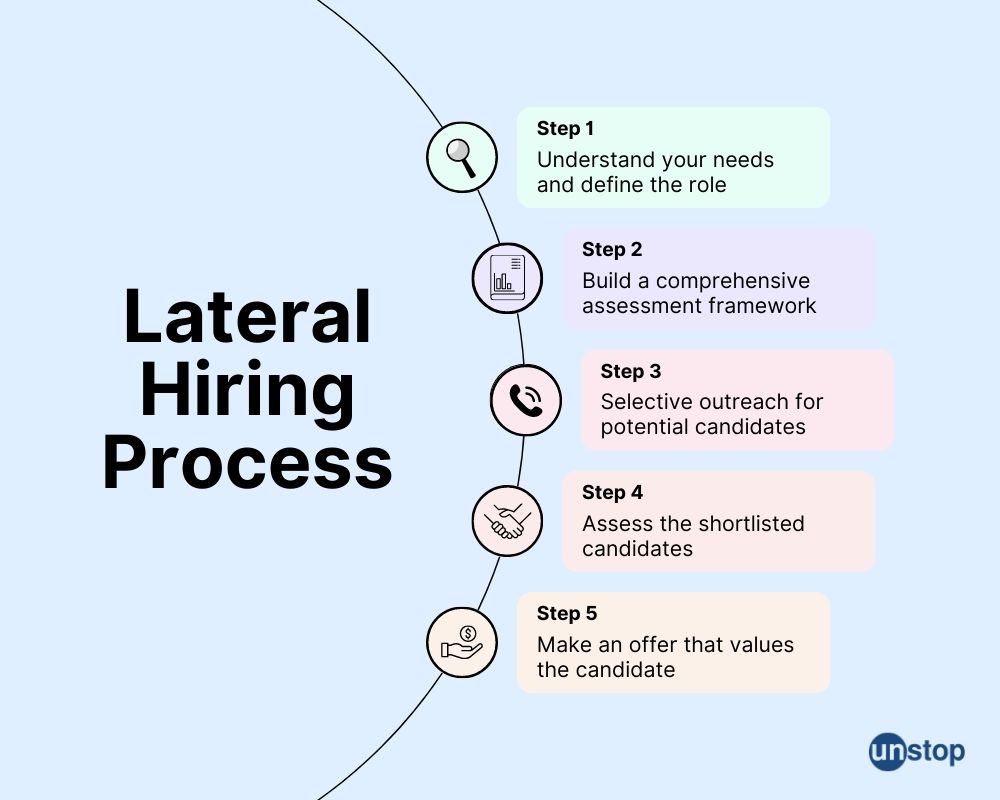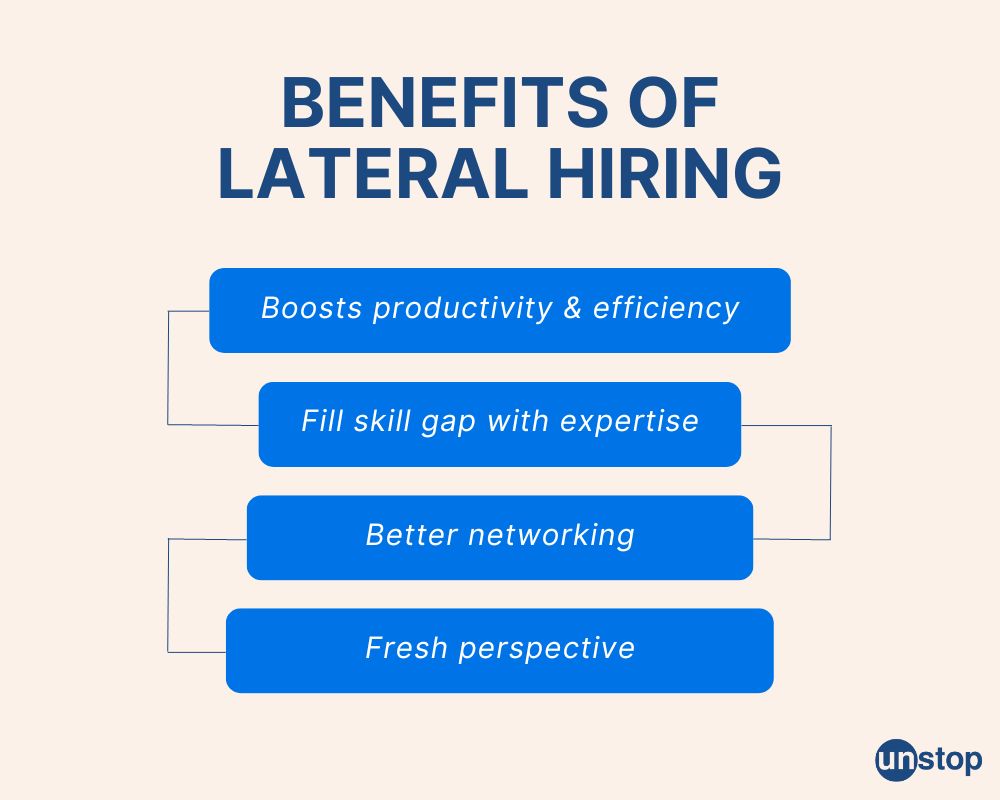- What's The Meaning Of Latering Hiring?
- Lateral Hiring vs Traditional Recruitment
- The Outline
- The Step-By-Step Guide
- Improving Retention Of Lateral Hires
- The Benefits
- What Can Go Wrong?
- Tips & Best Practices
Lateral Hiring: A Complete Guide To The Process, Its Benefits, Challenges & Best Practices

When it comes to hiring and recruitment, there are a few terms even the average Joe is aware of. Like salary, joining bonus, and pretty much anything related to compensation and holidays.
But, the world of hiring and recruitment looks very different when you're the one looking for the perfect candidate for the role - one who has the specific skill set and experience you require. That's where lateral hiring comes into the picture.
What's The Meaning Of Latering Hiring?
If you're wondering what is lateral hiring in the recruitment process, don't worry. Though it's one of the most prevalent hiring practices today, it's often carried out by external agencies (headhunters/hiring platforms/recruitment agencies, etc.) or senior HR executives in an organization. Certain organizations may even press for secrecy in the process, especially when hiring for senior leadership roles. Let's now understand the term with certain examples.
Lateral Hiring Meaning: Lateral hiring refers to the process of hiring individuals for a role that is the same (or similar) as their current role.
The term comes from the word lateral - which refers to horizontal movement from one side to the other. Thus, when an individual moves from one organization to another, but in the same role, it's referred to as lateral hiring. For example, when you hire a sales manager from another organization as a sales manager in your organization.
Lateral hiring specifically targets people outside of the organization, is usually done for senior roles, and focuses on individuals who have a very specific set of skills and experience. In certain cases, the potential candidates may also be familiar with the industry or even the company. For example, there is considerable lateral movement between the 'Big 4' financial advisory firms like EY, Deloitte, KPMG and PwC. In this instance, the candidate is highly familiar with the industry, even when changing organizations.
Quick Fact: Interestingly, lateral hiring is the most common in consulting industries and technology firms.
With organizations looking to hire the best talent, lateral hiring has become the go-to approach for many organizations. But, it's different from traditional recruitment.
Why do companies need lateral hiring?
The simple answer is a talent shortage. Organizations recognize a gap in their existing resources and strategically look to hire the best person to fill that vacancy - especially if the role is difficult to fulfill or critical for achieving set goals.
For example, an organization looking to expand its digital footprint may require a social media manager. Since it has not capitalized on social media in the past, it may not find anyone from the existing group of employees to take on the role. Thus, it will look to laterally hire another social media manager. And chances are high that the organization will look for someone who is experienced with the industry and the role.
Is there lateral movement within a firm?
Since companies require individuals with a specific skill set and experience, the talent pool they're looking at comprises individuals who're most likely satisfied in their current position and organization. Or at least, these individuals are not actively looking to change jobs - also referred to as passive candidates.
Moreover, because the role on offer is similar to a candidate's current position, companies may focus on monetary compensation instead of career promotion as an incentive. This is also why the focus is on candidates outside the firm; though exceptions exist i.e., instances where there is a lateral movement within the firm.
Lateral movement within a firm usually takes place when organizations recognize that an employee fits better in a different role; or if an employee wants to explore a different function/division. For example, a social media marketing executive moving to public relations.
A common example of lateral movement within a firm is internal relocation projects. Companies often look within the organization to find candidates for relocation, i.e. candidates willing to relocate to another country or city for a role.

Lateral Hiring vs Traditional Recruitment: How Are The Two Different?
By now, you've probably understood what is lateral hiring. But, not how it's different from traditional recruitment. To put it simply, lateral hiring is more specialized than traditional hiring.
In the traditional or normal hiring process, recruiters advertise the job opening on recruitment portals and/or job boards, and the candidates who're applying for the role are actively looking to get hired.
On the contrary, when it comes to lateral hiring, the talent pool is not made up of active job seekers. Lateral candidates are passive candidates. Thus, the recruiter has to deftly approach these candidates, after thorough research so they're aware of the key points that can motivate a candidate to switch jobs.
Thus, the major difference between hiring and lateral recruitment is the talent pool (passive vs active) and approach.
Lateral Hiring Process: The Outline

Now that we've understood what is lateral hiring and how it differs from traditional recruitment, let's take a look at the lateral hiring process. Here's a brief outline of the lateral recruitment process:
- Understand your needs and define the role
- Building a comprehensive assessment framework
- Selective outreach
- Contact and assess
- Make an offer
Lateral Hiring Process: The Step-By-Step Guide
Let's dig deeper into the lateral hiring process and understand each step in detail:
Understand the Needs & Define the Role
The first step in the process is for organizations to understand why they're hiring laterally. It's critical for both, the hiring manager and the department head to have absolute clarity on the purpose behind the hiring - and why is there a need for lateral hiring. It's only when the purpose of hiring is clear, that you can identify candidates who meet the requirements. To achieve this, individuals at the executive level of the department that has a vacancy need to be directly involved in the process.
Once the needs have been defined, organizations have to prepare a clear job description - one that accurately lists information about the industry and role and specifies the exact skill set required. This includes listing the soft skills and technical knowledge required for the role.
When hiring traditionally, a job description can include a broad set of skills. But not when hiring laterally - the whole purpose of hiring laterally is to find a prospective candidate that fits your requirement like pieces of a puzzle. Thus, defining the role appropriately becomes extremely important.
Build a Comprehensive Assessment Framework
Once you've understood your needs and defined the role, it's time to build a framework of assessment. In other words, you need to define the criteria on which you'll judge potential employees. Again, it's important that you map the assessment criteria against the required competencies and find a way to accurately test the knowledge of candidates. Hiring managers or teams can assign weightage to different factors in the assessment criteria and mark candidates accordingly.
For example, when hiring a technical content editor, you require an individual who is both, technically proficient and a good writer. Thus, the assessment tool should include questions on both parameters, like having a candidate write a code and provide its written explanation.
The efficacy of the framework assessment goes a long way in finding the most suitable candidates for the role, especially in a lateral hiring project.
Selective Outreach
You've defined the role and parameters for assessment. Now comes the most difficult part of the process - reaching out to the right candidate. The reason this is the most difficult step is that the talent pool you're looking for is made up of passive job candidates - those not in the job market, looking for a chance. When hiring experienced candidates, it's difficult to find candidates who're willing to swap job security and comfort with their current position for a new role. Thus, uou need to first ensure the candidate is open to the idea of shifting organizations. If they respond positively to the initial contact, you can proceed ahead and ask for a resume or other required details.
What adds to the difficulty is the lack of traditional hiring sources - especially when hiring for senior executive positions that require an element of secrecy. It's critical to adopt a strategic approach to audience outreach during lateral hiring planning.
Assess shortlisted candidates
At the end of your outreach, after screening resumes and vetting track records, you should have a potential candidate list. Now it's time to contact these candidates to schedule time for the assessment. This could be via an interview or other means, as defined in the framework.
The purpose of assessment is to determine the company/role-candidate fit. Thus, when interviewing, make sure that your interview questions focus on the required competencies i.e. go back to your assessment framework and test the performance of candidates.
Make an offer
This is the last stage of the lateral recruitment cycle. Once you've made the final decision on who to hire, it's time to make an offer. And yes, Godfather got it right - it's critical you make them an offer they can't refuse. Remember, the candidate is not looking to switch, and have no reason to haggle, negotiate and leave the comfort of their current role. In fact, a lateral job offer can be a boon for candidates - they may even use the offer to ask for a raise or promotion at their current organization.
At this stage of the recruitment cycle, you've also invested time and effort in finding the right candidate and would like to close the process. Thus, focus on factors beyond financial compensation as well. Financial compensation is attractive but often, in lateral hiring, a candidate is looking for something more. It could be a chance to learn something new, gather hands-on experience, or work on a new challenge. Understanding what motivates the candidate can go a long way in drafting the right offer. The idea is to provide an attractive environment to candidates, not just a handsome salary.
While you can't always predict the outcome, making data-backed hiring decisions through accurate assessments and analysis can limit the chances of a negative outcome.
Unstop offers advanced talent solutions to hire professionals and find the right for your organization. Find more information about hiring solutions offered by Unstop, including lateral hiring, here.
Improving Retention Of Lateral Hires
The lateral recruitment process does not end with onboarding the candidate. It's also important to ensure a new hire stays with the firm. Here are some ways of improving the retention of lateral hires:
i) Providing relevant information and tools: When you hire an experienced candidate for a role, provide them with the relevant information they require. Introductory meetings and materials that contain information about the role, access to common files and folders, etc. can go a long way in helping new hires get comfortable with the role.
ii) Informal connect: Organizations can set up informal meetings and events outside of working hours to help new employees connect and bond with existing employees. This also helps break the ice faster than usual.
iii) Peer connect: Assigning buddies or peer mentors is an effective tool to improve retention. New employees need help and/or guidance with several things - everything about a new working environment is unfamiliar to them. A peer or buddy can considerably ease the process of navigating a new work environment.
iv) Set goals and timelines: It's important that new hires understand what's expected of them. Setting time-bound deliverables can help them work towards the goal. Expectation setting also helps new employees get a better idea about the way the company functions.
v) Provide timely feedback: Timely feedback can help employees understand if their efforts are yielding the required results. It also enables them to identify and work on areas of improvement.
Lateral Hiring In The Recruitment Process: The Benefits

Lateral hiring in the recruitment process has several advantages, such as:
- Increased Efficiency: The primary benefit of the lateral recruitment process is increased efficiency. Since the employee hired through a lateral recruitment project is experienced and has the requisite skill set, they're more likely to hit the ground running and help boost productivity.
- Filling Skill Gaps with Expertise: The whole purpose of lateral recruitment is to find the desired expertise to fill a skill gap in a team. The selected candidate brings much-needed expertise and knowledge, helping an organization ramp up its processes.
- Networking: When an experienced candidate is hired, especially in a leadership role, it opens up several new networking opportunities for the organization.
- Fresh perspective: A new, experienced hire can offer a fresh perspective. Not only does this help solve old problems, but can also improve operations.
Lateral Hiring: What Can Go Wrong?
We've discussed in detail the process of lateral hiring and its advantages. But, there are two major challenges or disadvantages to the process:
i) Incompatibility: There is always a risk that a new hire may not align with the company culture. Since lateral hires are experienced individuals, they are also accustomed to working in a particular type of organization. Fitting into a new environment may prove to be difficult.
ii) More expensive: Lateral hiring is usually more expensive, because experienced individuals demand a higher salary - especially when they've been approached for a role and are not the one looking for a job.
Lateral Hiring: Tips & Best Practices
Following are some tips and tricks to keep in mind when engaging in lateral recruitment:
- Be clear about your needs
- Ensure the job description accurately captures your requirements
- Prepare a comprehensive assessment framework
- Exercise discretion in approaching candidates
- Accurately assess potential candidates against defined criteria
- Be fair and honest - don't sugarcoat or mislead a potential candidate
- Make an irresistible offer
Now that you've understood the process of lateral hiring, its advantages and disadvantages in detail, you're well prepared to make a decision about whether this is the recruitment solution you're looking for.
Suggested Reads:
I’m a reader first and a writer second, constantly diving into the world of content. If I’m not writing or reading, I like watching movies and dreaming of a life by the beach.
Login to continue reading
And access exclusive content, personalized recommendations, and career-boosting opportunities.
Subscribe
to our newsletter
Blogs you need to hog!

Organize Hackathons: The Ultimate Playbook With Past Case Studies

What is Campus Recruitment? How To Tap The Untapped Talent?

Lateral Hiring: A Complete Guide To The Process, Its Benefits, Challenges & Best Practices













Comments
Add comment